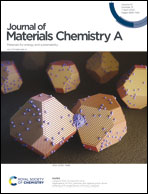Defect and interface engineering in metal sulfide catalysts for the electrocatalytic nitrogen reduction reaction: a review
Abstract
The development of a green and sustainable process for electrochemical ammonia synthesis has a significant impact on modern society in terms of agricultural and industrial development, as well as energy reform. The electrocatalytic nitrogen reduction reaction (NRR) has been regarded as a promising strategy and the efficiency of the NRR strongly depends on electrocatalysts with excellent activity, selectivity, and stability. Metal sulfides have been regarded as potential electrocatalysts due to the “accept and back-donate” interaction of metals with N2. In addition, it has been proposed that both the intrinsic and extrinsic catalytic activity, selectivity and stability of metal sulfides can be improved through defect and interface engineering. In this review, the recent progress on metal sulfides toward the NRR is summarized based on defect and interface engineering. The typical synthetic methods, physicochemical properties, and catalytic performances of the catalysts are outlined to provide insights into the structure–performance relationship of the catalysts. In particular, the origin of the outstanding NRR catalytic activity, selectivity and stability was revealed from both experimental and theoretical perspectives. Furthermore, the remaining challenges and future perspectives are presented with the aim of providing insightful guidance for developing more efficient NRR electrocatalysts.



 Please wait while we load your content...
Please wait while we load your content...